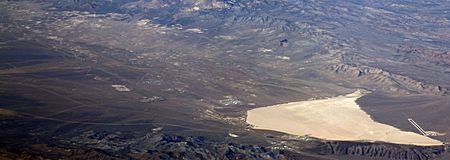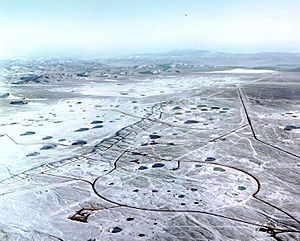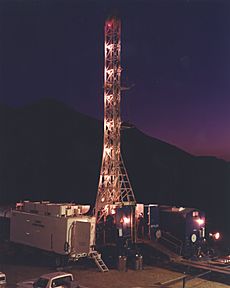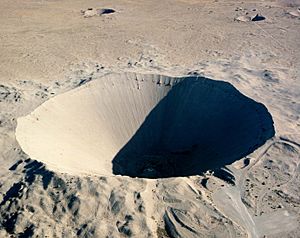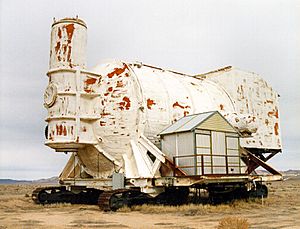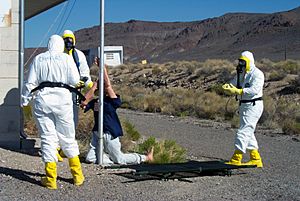Yucca Flat facts for kids
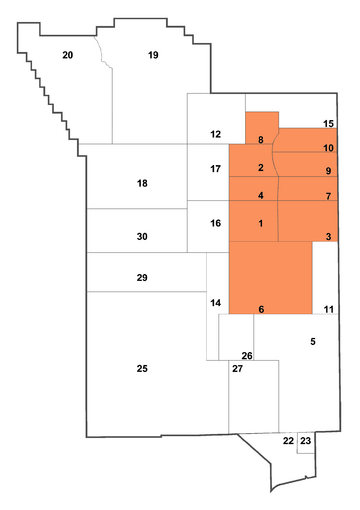
Yucca Flat is a dry desert area. It is one of four main places where nuclear tests happened at the Nevada Test Site (NTS). This area is split into nine sections, from Area 1 to 4 and Area 6 to 10. Yucca Flat is on the eastern side of the NTS. It is about 10 miles (16 km) north of Frenchman Flat. It is also about 65 miles (105 km) from Las Vegas, Nevada. Yucca Flat was used for 739 nuclear tests. This means almost four out of every five tests at the NTS happened here.
Yucca Flat has been called "the most nuclear-blasted spot on Earth." In March 2009, TIME magazine said the 1970 Yucca Flat Baneberry Test was one of the world's worst nuclear accidents. In this test, 86 workers were exposed to radiation.
Contents
What the Ground is Like (Geology)
The ground in Yucca Flat is open and sandy. This made it easy to film nuclear tests that happened in the air. When tests moved underground, the deep layers of soil were good for drilling test holes. This soil came from mountains wearing down over time.
Hundreds of subsidence craters are on the desert floor. A crater forms when an underground nuclear explosion turns rock and soil into vapor. This vapor then cools into liquid rock. The ground above the explosion often sinks into the empty space, making a crater.
At the south end of Yucca Flat is Yucca Lake. It is also called Yucca Dry Lake. This dry, salty lake bed has a runway called Yucca Airstrip. The Army Corps of Engineers built it before nuclear testing started. West of the dry lake is News Nob. This rocky spot was where reporters and important guests watched nuclear tests in the air.
Nearby Places
West of the dry lake, at the top of Yucca Pass, is Control Point, or CP-1. This is a large building complex, about 31,600 square feet (2,936 sq m). It holds equipment for testing and monitoring nuclear tests. It also has a cafeteria that can seat 32 people. CP-1 looks over both Yucca and Frenchman Flats. Today, Control Point is the main support center for all activities at the NTS.
In nearby Area 5, there is a crater. This crater holds storage containers with contaminated metal and other waste. The levels of radioactivity there are checked regularly.
Nuclear Testing History
Yucca Flat had 739 nuclear tests. These tests included 827 separate explosions. The higher number of explosions happened because some tests had multiple nuclear blasts. These blasts occurred within 0.1 seconds of each other and within a 2 km (1.2 mi) wide circle. Sixty-two such tests took place at NTS.
No test at Yucca Flat ever had an expected power greater than 500 kilotons. Tests with bigger explosions happened at Rainier Mesa and Pahute Mesa. Their ground allowed for deeper test shafts.
First Tests
The first test explosion at Yucca Flat happened after five earlier tests in nearby Area 5. These were part of Operation Ranger. On October 22, 1951, the "Able" test of Operation Buster exploded. It was set off at the top of a tower in Area 7. The explosion was very small, less than one kilogram of TNT. It was the world's first nuclear device that failed to explode properly. Over the next two weeks, four successful tests happened. Bombers dropped nuclear weapons over Area 7.
The first underground test at NTS was the "Uncle" shot of Operation Jangle. Uncle exploded on November 29, 1951. It happened inside a shaft dug into Area 10.
Operation Plumbbob
In Area 9, the "Hood" test happened on July 5, 1957. It was part of Operation Plumbbob. This 74-kiloton test was the largest atmospheric test ever in the United States. It was almost five times more powerful than the bomb dropped on Hiroshima. A balloon carried Hood 460 meters (1,509 ft) above the ground before it exploded. Over 2,000 troops took part in the test. They were training for operations on a nuclear battlefield. This test released 11 MCi (407 PBq) of iodine-131 into the air. Iodine-131 has a short half-life of eight days. It helps track specific nuclear contamination. It makes up about 2% of radioactive materials in a nuclear dust cloud. It can cause thyroid problems if swallowed.
The "John" shot of Plumbbob happened on July 19, 1957. It was the first test of the nuclear-tipped AIR-2 Genie rocket. This rocket was made to destroy enemy bombers with a nuclear explosion. The two-kiloton warhead exploded about 3 miles (4.8 km) above five volunteers and a photographer. They stood unprotected at "ground zero" in Area 10. This was to show that battlefield nuclear weapons were safe for people on the ground. The test also showed that a fighter jet could launch a nuclear rocket and not be destroyed. A Northrop F-89J plane fired the rocket.
A very different test was the "Sedan" test. It happened on July 6, 1962, as part of Operation Storax. This 104-kiloton test was for Project Plowshare. This project wanted to see if nuclear weapons could be used for peaceful things. For example, creating lakes, bays, or canals. The explosion moved twelve million tons of earth. It made a crater 1,280 feet (390 m) wide and 320 feet (98 m) deep in Area 10. For an underground test, a lot of energy escaped into the air. It was about 2.5 kilotons. Two radioactive dust clouds rose from the explosion. They traveled across the United States. One was at 10,000 feet (3,048 m) and the other at 16,000 feet (4,877 m). Both dropped radioactive particles across the USA before going over the Atlantic Ocean. The clouds carried 880 kCi (32.56 PBq) of 131I, among other radioactive materials.
Sedan Crater was added to the National Register of Historic Places in 1994.
Baneberry Accident
Area 8 was where the "Baneberry" test happened. It was part of Operation Emery on December 18, 1970. The Baneberry 10-kiloton test exploded 900 feet (274 m) below the surface. But its energy cracked the soil in unexpected ways. This caused a crack near where the explosion happened. A cloud of fire and dust was released three and a half minutes later. It rained fallout on workers in different parts of the NTS. The radioactive cloud released 6.7 MCi (248 PBq) of radioactive material. This included 80 kCi (2.96 PBq) of iodine-131. After dropping some material locally, the lighter particles were carried by winter storms and the jet stream. They fell heavily as radioactive snow in parts of California, Idaho, Nevada, Oregon, and Washington. The jet stream layers carried radioactive materials across the US to Canada, the Gulf of Mexico, and the Atlantic Ocean.
About 86 workers at the site were exposed to radioactivity. However, the Department of Energy said no one received too much radiation. They also said radiation drifting offsite was not dangerous. In March 2009, TIME magazine called the Baneberry Test one of the world's worst nuclear disasters.
Two US court cases came from the Baneberry event. Two NTS workers who were exposed to high radiation died in 1974. Both had a type of blood cancer called acute myeloid leukemia. The court found that the Government was careless. But it also found that the radiation from the Baneberry test did not cause the cancer cases. This decision was upheld in 1996.
Huron King Test
As part of Operation Tinderbox, on June 24, 1980, a small satellite model was tested. It was exposed to radioactivity from the "Huron King" test. This was a special test done in Area 3. The goal was to improve how defense satellites are built to withstand nuclear radiation. In this test, a nuclear device (less than 20 kilotons) was placed at the bottom of a shaft. A satellite or other experiment was put in a test chamber at the top. This chamber was partly emptied to act like space. When the test started, radiation from the device shot up the pipe to the chamber. Then, mechanical covers sealed the pipe. This stopped the explosion's shock wave from damaging the targets. The test chamber was quickly moved to safety before the ground could sink and form a crater. The Huron King test cost about $10.3 million in 1980.
Last Test
The last test at Yucca Flat was "Divider" on September 23, 1992. It was also the last test at the entire Nevada Test Site. This happened just before a temporary halt to all nuclear testing. Divider was a safety experiment test. It was exploded at the bottom of a shaft in Area 3.
Abandoned Tests
Three tests planned for 1993 were stopped. Two of them were in Yucca Flat. The Comprehensive Nuclear-Test-Ban Treaty was strongly supported by the UN in 1991. Talks for this treaty began in 1993. The United States stopped all nuclear weapons testing programs on October 3, 1992. This was in preparation for possibly signing the treaty. The partially set up cables, towers, and equipment for "Icecap" in Area 1 and "Gabbs" in Area 2 are still there. They are waiting for nuclear testing to possibly start again. The "Greenwater" test is waiting in Area 19 at Pahute Mesa. "Icecap" was planned as a joint test between the US and the UK.
Radioactivity in the Area
Underground Test Area (UGTA)
The United States Department of Energy released a report in April 1997. It was about a part of the Nevada Environmental Restoration Project. This larger project cleans up and fixes environmental problems at the NTS. It also covers other sites in different states. The Underground Test Area (UGTA) project focuses on finding the edges of areas with unsafe water. This water is contaminated with radioactive materials from underground nuclear tests. This project is ongoing. It aims to predict how far contaminated water will spread naturally. It also wants to figure out safe limits for human health. Yucca Flat was named a "Corrective Action Unit." Cleaning up the Nevada Test Site is very expensive and almost impossible. Because of this, it has been called a "national sacrifice zone."
USGS Studies
In 2003, the United States Geological Survey (USGS) collected data at the Nevada Test Site. They used special equipment at 51 stations in and near Yucca Flat. This was to get a better idea of the old rock layers under Yucca Flat. The goal was to understand the type, thickness, and spread of these rock formations. These rocks affect how underground water flows. A main goal was to map the "upper clastic confining unit" in the Yucca Flat area.
First Responder Training
The radioactivity on the ground in Area 1 helps train first responders. Trainees learn how to detect radiation and understand its health dangers. More training happens in other areas of the NTS.


